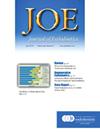Intracanal Antibacterial Effects of a Bioceramic Medication Compared With Calcium Hydroxide Pastes in Different Vehicles
IF 3.5
2区 医学
Q1 DENTISTRY, ORAL SURGERY & MEDICINE
引用次数: 0
Abstract
Introduction
The intracanal antibacterial effectiveness of a bioceramic medication was compared with calcium hydroxide pastes in different vehicles.
Methods
Extracted mandibular incisors with a single long oval canal were selected and distributed into 5 groups based on anatomically paired microcomputed tomographic analyses. The root canals were prepared up to an instrument size 35/04 and contaminated for 30 days with a mixed bacterial culture from subgingival biofilm added with Enterococcus faecalis. The canals were medicated with Bio-C Temp (Angelus Indústria de Produtos Odontológicos, Londrina, PR, Brazil) or a calcium hydroxide paste in glycerin, camphorated paramonochlorophenol and glycerin (CHPG), or 2% chlorhexidine (CHCX). Control specimens were filled with sterile saline. After 7 days, the medication was removed by using rotary instruments and saline irrigation. A supplementary approach was conducted, which consisted of 2.5% sodium hypochlorite irrigation and agitation with XP-endo Finisher. Bacteriological samples were taken before application (S1) and after removal (S2) of the intracanal medication, and after the supplementary approach (S3). Bacterial DNA extracted from the samples was quantified using real-time polymerase chain reaction.
Results
Bacterial counts were significantly reduced from S1 to S2 in all groups, except for the control group. As for S1-to-S3 changes, all groups (control included) showed significant bacterial reduction. S2-to-S3 changes were only significant in the CHPG and CHCX groups (P < .05). Intergroup comparisons showed no significant differences in S2 (P > .05), with all medications significantly better than the control (P < .05). In S3, only the CHPG and CHCX groups showed further significant bacterial reductions. Categorical data analysis showed no intergroup differences (P > .05).
Conclusions
All tested medications significantly reduced the intracanal bacterial counts, with no significant differences between them. Final sodium hypochlorite irrigation and agitation using XP-endo Finisher further enhanced disinfection in the CHCX and CHPG groups.
一种生物陶瓷药物与氢氧化钙糊剂在不同载体中的抗菌效果比较。
介绍:比较了一种生物陶瓷药物与氢氧化钙糊剂在不同载体中的抗菌效果。方法:选取单根长卵圆管的下颌切牙进行解剖配对显微计算机断层扫描,分为5组。根管准备至35/04仪器尺寸,用添加粪肠球菌的龈下生物膜混合细菌培养物污染30天。用Bio-C Temp (Angelus Indústria de Produtos Odontológicos, Londrina, PR, Brazil)或氢氧化钙糊剂(含甘油、樟脑化的副氯酚/甘油(CHPG)或2%氯己定(CHCX))治疗管。对照标本用无菌生理盐水填充。7天后,用旋转器械和盐水冲洗将药物取出。补充方法为2.5% NaOCl灌洗和XP-endo整理剂搅拌。在给药前(S1)、取出药后(S2)和补充入路后(S3)分别取细菌学样本。从样品中提取的细菌DNA采用实时聚合酶链反应进行定量。结果:除对照组外,各组细菌计数均由S1降至S2。s1 - s3变化,各组(包括对照组)细菌数量均显著减少。仅CHPG组和CHCX组s2 - s3变化显著(p0.05),所有药物均显著优于对照组(p0.05)。结论:所有被试药物均可显著降低肛管内细菌计数,且差异无统计学意义。最后用XP-endo Finisher冲洗和搅拌NaOCl, CHCX组和CHPG组的消毒效果进一步增强。
本文章由计算机程序翻译,如有差异,请以英文原文为准。
求助全文
约1分钟内获得全文
求助全文
来源期刊

Journal of endodontics
医学-牙科与口腔外科
CiteScore
8.80
自引率
9.50%
发文量
224
审稿时长
42 days
期刊介绍:
The Journal of Endodontics, the official journal of the American Association of Endodontists, publishes scientific articles, case reports and comparison studies evaluating materials and methods of pulp conservation and endodontic treatment. Endodontists and general dentists can learn about new concepts in root canal treatment and the latest advances in techniques and instrumentation in the one journal that helps them keep pace with rapid changes in this field.
 求助内容:
求助内容: 应助结果提醒方式:
应助结果提醒方式:


